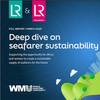Company Profile: Autoship Systems Corp.
In the early 1980s, PCs were beginning to have respectable computing power at a relatively affordable price. This situation encouraged Grahame Shannon of Vancouver, Canada to develop his idea of designing vessels on the PC-platform. Soon Shannon had many naval architects knocking at his door. His design software, called Autoship, had apparently made the vessel designer’s life a lot easier. Before long Shannon had to hire employees and move his business, Coastdesign Inc., out of his basement.
Coastdesign Inc. quickly built its reputation as a CAD software specialist. Dealerships were established in key maritime countries, such that by the late 1980s the company had a strengthened position among the PC-based CAD software suppliers around the world. Coastdesign had, by this time, licensed and developed analysis tools to complement Autoship. These new software tools comprised: AutoPlex (for designing with developable surfaces); Autoplate (for plate expansion); GHS (for stability and longitudinal strength analysis); and Autopower (for resistance calculations and powering estimation). A total CAD solution, whereby software could be used to take the vessel design completely around the design spiral, had emerged.
Now was the time to tie the design process with vessel construction, a link between vessel design and construction that was made in two steps.
First, Autobuild – an internal structural modeling program was developed. Second, AutoNC, a nesting and cut-file generation program, was licensed. Now, parts created in the Autoship CAD suite could be exported using standard dxf file format to AutoNC for part nesting and cutting. The CAD programs also advanced, with Autoplex being integrated into Autoship, and GHS being replaced by Autohydro. The company, now called Autoship Systems Corporation, had a complete CADCAM software product line.
The First Autoship CADCAM Suite
Since these early days, Autoship Systems continued to innovate. In the early 1990s, all products were re-written to move from the DOS operating environment to Windows. Further, the products have undergone continuous improvement, taking advantage of increased computing power available in PCs, and more advanced programming tools. Finally, ASC has further proved its commitment to making the vessel design and construction process easier by integrating with third party software.
Today, the Autoship CADCAM suite is as follows:
- Autoship – for surface modeling. The Autoship program uses Non-Uniform Rational B-Spline (NURBS) mathematics, the high-end CAD standard for surface modeling.
- Autopower – for resistance and powering prediction. Twelve independent resistance and propulsion methods for variety of hull forms are offered.
- Autohydro – for stability and strength calculations. The program performs damage and intact stability analyses on a 3D model of the vessel. The program input can either be an Autoship-generated model, or a table of offsets.
- Autostructure – for internal structure design. This is a group of programs consisting of: Project Manager – for project management, Autostructure – for design work, and Report Manager – for report generation. Autostructure is built on top of the Microsoft SQL Server database
- Autoplate – for plate design and expansion. The program performs plate expansion calculations for both developable and non-developable plates. It helps in the layout and forming of the shell plating. It is based on a modern proprietary expansion algorithm.
- Production Manager – for nesting and stock management. The foundation of Production Manager is the Autostructure database. Parts for nesting are read from the database; nestings and inventories are stored in it. Production Manager exports nesting drawings and tables into AutoCAD.
Third Party Integration
In today’s shipyard, there are many different software packages in use. The individual software alone may improve efficiencies within a given department, however the real benefit of these disparate packages can only be realized through meaningful data transfers between these systems. Ultimately, the supply chain will still experience bottlenecks if these links are not made. ASC understands the shipyard supply chain and therefore continues to work hard to integrate their state-of-the-art CADCAM systems with other notable shipyard software.
To this end, some key Autoship CADCAM suite interfaces with third-party software systems include:
- Autoship. Models created in other programs can be imported via IGES or DXF. In addition, if the vessel designer wants to start his vessel in the Autoship suite from the lines of an existing vessel, this is possible with the surface match routine (available only in Autoship Pro). The user has two ways to enter the data: a. manually typing in offsets into a table; or b. by importing the existing vessel’s offsets using a “csv” (comma separate variable) file format – a file format easily created from a Microsoft ExCel spreadsheet. Either way, the surface match routine will generate a set of curves from the data, and then loft a surface through them.
- Autostructure. Autostructure interfaces with two third party software: AutoPLANT and AutoCAD:
a. AutoPLANT is a third party piping design software. The link between Autostructure and AutoPLANT ensures that any conflict between piping system design and structural design is resolved during the vessel design stage, rather than during the vessel construction stage.
b. AutoCAD is used by Autostructure for editing 2-D flat parts, and exporting of parts, assemblies and cross-sections in 2-D and 3-D.
- Production Manager. Production Manager exports nesting drawings and tables to AutoCAD. Optionally, the program operator can write out a DWG file.
Autoship has not stopped the third party integration process. For example, Autoship has an agreement with SPAR Associates, Inc www.sparusa.com for an interface between Perception software of SPAR and the Autoship CAD suite. The interface means that material requirements determined in the design process can be transmitted exactly and a timely fashion to the supply management software of the Perception suite.













